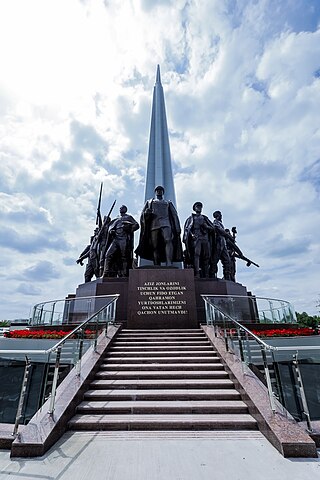Related Research Articles

The Armed Forces of the Republic of Uzbekistan, is the name of the unified armed forces of Uzbekistan, consisting of the Ground Force and the Air and Air Defence forces under the defence ministry. Paramilitary units include the National Guard, a Frontier Service and a River Force. It is reported to be the largest and the strongest in Central Asia.

Tashkent, or Toshkent in Uzbek, is the capital and largest city of Uzbekistan. It is the most populous city in Central Asia, with a population of more than 3 million people as of April 1st 2024. It is located in northeastern Uzbekistan, near the border with Kazakhstan.
The following is a timeline of the history of the city of Tashkent, Uzbekistan.

The Navoi Theater is the national opera theater in Tashkent, Uzbekistan.

Independence Square is a central square of Tashkent, Uzbekistan.

The Museum of Arts of Uzbekistan is the largest state art museum in Uzbekistan. Its permanent collection contains more than several thousands works, divided among four curatorial departments. The museum was established in 1918 as a Museum of People University and renamed as a Central Arts Museum later. It was named as Tashkent Art Museum in 1924 and finally Museum of Arts of Uzbekistan in 1935.
The Museum of Communication History in Uzbekistan, is a unique and the first museum in the history of Uzbekistan which is related to the communication technologies. It was established in 2009, and nowadays the museum became one of the most famous museums among Uzbek people.

Museum of Victims of Political Repression in Tashkent — is a museum which tells the history of Uzbekistan during the political repression in the Soviet Union, in particular that of the people killed at that time. The Museum is divided into 10 parts.

The Museum of Geology in Tashkent, Uzbekistan is a geology museum that shows and represents the wealth of mineral and geological resources in Uzbekistan, including valuable stones, minerals and archaeological and paleontological findings.
The Uzbekistan State Museum of Nature is the oldest museum operating in Uzbekistan. The museum's main purpose is to show the natural beauty of Uzbekistan and to help protect its environment. The museum features chronologically-ordered exhibits and seeks to educate visitors about Uzbekistan's geography through time.
Art Gallery of Uzbekistan is established in Tashkent city, after the Independence of Republic Uzbekistan, and became one of the most visited modern museums of local people in Uzbekistan.
The Tashkent Polytechnical Museum is an automotive museum in Tashkent, Uzbekistan. The museum provides technical and mechanical information about cars made from 1800 to 1900, focusing on the history of automobile technology and production in Uzbekistan and around the world. It is located in the Mirabad district of Tashkent.
The Museum of Health Care of Uzbekistan is in Uzbekistan. It was established in order to contribute information about the medicine and hygiene among the Uzbek people in an interesting way.
Tashkent Planetarium is one of the newest constructions in Uzbekistan, and is visited by local people and tourists. Tashkent Planetarium provides visitors with the opportunity to look at outer space, even in the morning, and enlarge their knowledge about the cosmos and the whole universe.

The Cathedral of the Assumption of the Virgin or more properly the Cathedral of the Dormition of the Mother of God is the Russian Orthodox cathedral of the diocese of Tashkent in Uzbekistan since 1945. The cathedral was built in 1871 and enlarged in the 1990s, the bell tower was rebuilt in 2010.

Victory Park, also known as the Victory Park Memorial Complex is a park located in Tashkent, the capital of Uzbekistan. It was planned in honor of the 75th anniversary of the end of the Second World War.
The State Museum of the Armed Forces of Uzbekistan is an institution located in northern Tashkent, the capital of Uzbekistan. It is under the direct control of the Ministry of Defense and serves as one of its cultural institutions. The museum has over 10,000 pieces of Uzbek military memorabilia, dating back from Great Patriotic War era equipment to military artifacts from the Timurid dynasty. The total area is 3,000 square meters.

The Amir Timur Square is the main town square in Tashkent, Uzbekistan.

Odina Mosque is the oldest preserved architectural monument located in the city of Qarshi, Qashqadaryo region. The mosque is situated in the center of the Qarshi fortress. Timur, during his expedition from Samarkand to Qarshi in 1385-1386, ordered the construction of this mosque.

The Peoples' Friendship Palace is the concert and cinema hall in Tashkent, capital city of Uzbekistan. The building was designed by architect Yevgeny Rozanov from the Moscow Architectural Institute who one decade prior to that worked on the city's Lenin Museum, modern day State Museum of History of Uzbekistan. The building was completed in 1981. As the largest cinema and concert hall in the country the palace provides seating for up to 6,000 people. The palace is named in the memory of solidarity and friendship of volunteers who came to the city after the devastating 1966 Tashkent earthquake. Up until 2020 the palace is represented on the 100 Uzbekistani sum banknote.
References
- ↑ "Independence Square (Mustakillik Square) (Tashkent) - 2018 All You Need to Know Before You Go (with Photos)". Tripadvisor.com. Retrieved 25 April 2018.
- ↑ "Xotira muzey". Xotira-muzey.uz.
- ↑ About Square in Journals Archived April 14, 2016, at the Wayback Machine
- ↑ "Ajdodlar ruhiga ehtirom". O‘zbekiston Milliy axborot agentligi. Retrieved 25 April 2018.
- ↑ "Museums of Tashkent :: List and details of the most interesting Tashkent museums". Orexca.com.
